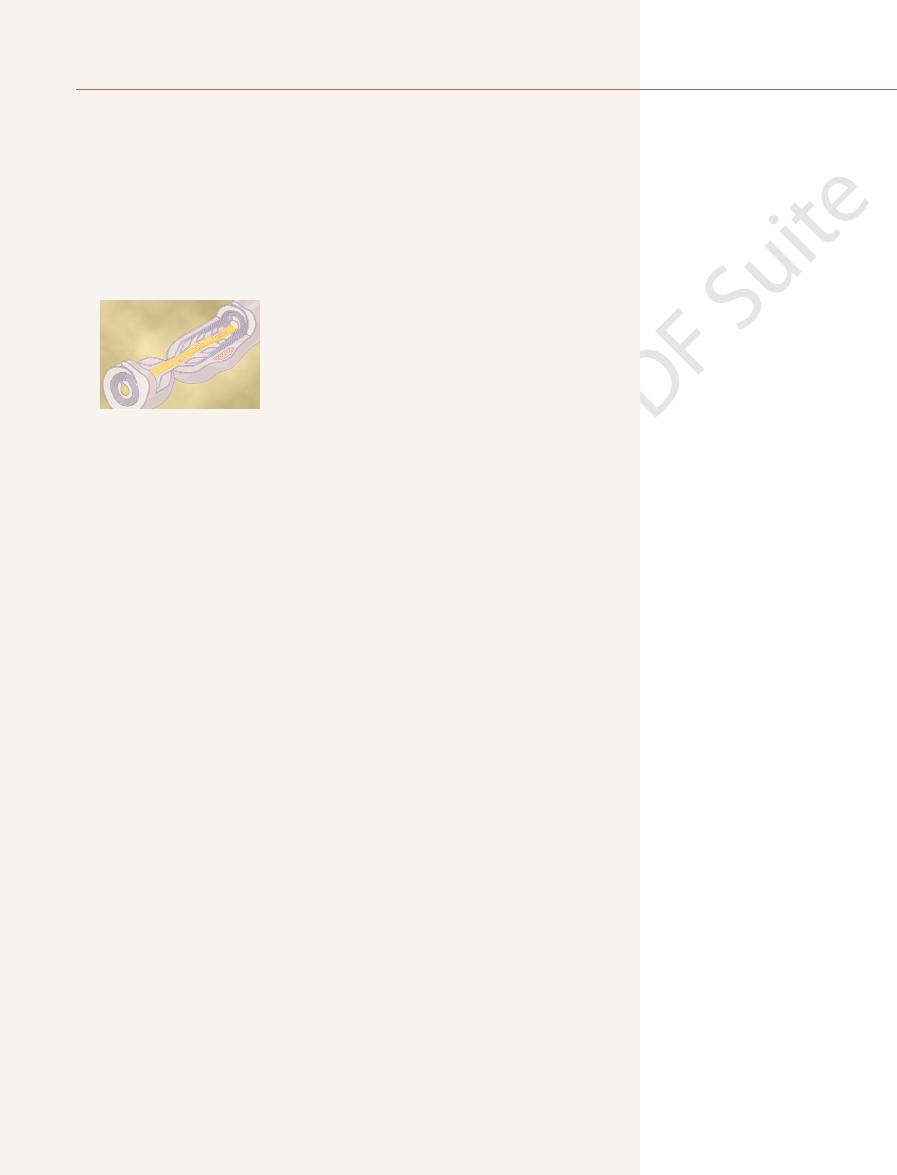
changing diffusion potentials.
tions, create a membrane potential. In later sections of this chapter, we show
ions across a selectively permeable membrane can, under appropriate condi-
Thus, in both parts of Figure 5–1, we see that a concentration difference of
the fiber.
in the mammalian nerve fiber,
to block further net diffusion of sodium ions to the inside; however, this time,
ity inside. Again, the membrane potential rises high enough within milliseconds
, with negativity outside and positiv-
of opposite polarity to that in Figure 5–1
permeable to the sodium ions but impermeable to all other ions. Diffusion of
. These ions are also positively charged. This time, the membrane is highly
shows the same phenomenon as in Figure 5–1
Figure 5–1
with negativity inside the fiber membrane.
the potential difference required is about 94 millivolts,
mammalian nerve fiber,
exterior, despite the high potassium ion concentration gradient. In the normal
so, the potential difference between the inside and outside, called the
behind and do not diffuse outward with the potassium. Within a millisecond or
electrical charges to the outside, thus creating electropositivity outside the
to diffuse outward through the membrane. As they do so, they carry positive
toward outside, there is a strong tendency for extra numbers of potassium ions
other ions. Because of the large potassium concentration gradient from inside
the membrane. Let us assume that the
In Figure 5–1
“Diffusion Potential” Caused by an Ion Concentration Difference on the Two Sides of the
Membrane Potentials Caused by Diffusion
during action by nerve and muscle cells.
in membrane potentials also activate many of the cells’ functions. The present
cells, macrophages, and ciliated cells, local changes
branes. In still other types of cells, such as glandular
at their membranes, and these impulses are used to
such as nerve and muscle cells, are capable of gen-
virtually all cells of the body. In addition, some cells,
Action Potentials
Membrane Potentials and
C
H
A
P
T
E
R
5
57
Electrical potentials exist across the membranes of
erating rapidly changing electrochemical impulses
transmit signals along the nerve or muscle mem-
discussion is concerned with membrane potentials generated both at rest and
Basic Physics of Membrane Potentials
Membrane.
A, the potassium concentration is great inside a nerve
fiber membrane but very low outside
membrane in this instance is permeable to the potassium ions but not to any
membrane and electronegativity inside because of negative anions that remain
diffusion
potential, becomes great enough to block further net potassium diffusion to the
B
A, but this time
with high concentration of sodium ions outside the membrane and low sodium
inside
the positively charged sodium ions to the inside creates a membrane potential
A
the potential is about 61 millivolts positive inside
that many of the rapid changes in membrane potentials observed during nerve
and muscle impulse transmission result from the occurrence of such rapidly

ions, the diffusion potential that develops depends on
When a membrane is permeable to several different
Several Different Ions
When the Membrane Is Permeable to
Calculation of the Diffusion Potential
inside the membrane.
10 times that on the outside, the log of 10 is 1, so that
is negative (–) if the ion is positive. Thus, when the con-
fusing from inside to outside is a negative ion, and it
potential is the potential inside the membrane. Also,
membrane remains at zero potential, and the Nernst
When using this formula, it is usually assumed that
where EMF is electromotive force.
additional net diffusion. The following equation, called
for the ion to diffuse in one direction, and therefore
brane. The greater this ratio, the greater the tendency
duced in Chapter 4. The magnitude of this Nernst
for that ion, a term that was intro-
The diffusion potential level
Membrane Physiology, Nerve, and Muscle
58
Unit II
Relation of the Diffusion Potential to the Concentration Differ-
ence—The Nernst Potential.
across a membrane that exactly opposes the net diffu-
sion of a particular ion through the membrane is called
the Nernst potential
potential is determined by the ratio of the concentra-
tions of that specific ion on the two sides of the mem-
the greater the Nernst potential required to prevent
the Nernst equation, can be used to calculate the
Nernst potential for any univalent ion at normal body
temperature of 98.6°F (37°C):
the potential in the extracellular fluid outside the
the sign of the potential is positive (
+) if the ion dif-
centration of positive potassium ions on the inside is
the Nernst potential calculates to be –61 millivolts
61 log
EMF millivolts
Concentration inside
Concentration outside
(
)
= ±
The method for measuring the membrane potential is
of this chapter.
nerves, which is the subject of most of the remainder
does not change greatly during this process. Therefore,
changes during transmission of a nerve impulse,
Fourth, as explained later, the permeability of the
leaving the nondiffusible positive ions on the outside.
tively charged chloride ions diffuse to the inside, while
is, a chloride ion gradient from the
occurs when there is a gradient for a negative ion. That
electronegativity on the inside. The opposite effect
fusible negative anions on the inside, thus creating
concentration is higher inside than outside. This carries
ativity inside the membrane. The reason for this is that
Third, a positive ion concentration gradient from
them alone.
equal to the Nernst potential for sodium. The same
sodium ions alone, and the resulting potential will be
and chloride ions, the membrane potential becomes
brane permeability for that particular ion.That is, if the
Second, the degree of importance of each of the ions
system. The concentration gradient of each of these
bers, as well as in the neuronal cells in the nervous
equation. First, sodium, potassium, and chloride ions
), are involved.
univalent negative ion, chloride (Cl
), and one
tive ions, sodium (Na
the membrane. Thus, the following formula, called the
to each ion, and (3) the concentrations (
of each ion, (2) the permeability of the membrane (
three factors: (1) the polarity of the electrical charge
P)
C) of the
respective ions on the inside (i) and outside (o) of
Goldman equation, or the Goldman-Hodgkin-Katz
equation, gives the calculated membrane potential on
the inside of the membrane when two univalent posi-
+
) and potassium (K
+
–
Let us study the importance and the meaning of this
are the most important ions involved in the develop-
ment of membrane potentials in nerve and muscle
fi
ions across the membrane helps determine the voltage
of the membrane potential.
in determining the voltage is proportional to the mem-
membrane has zero permeability to both potassium
entirely dominated by the concentration gradient of
holds for each of the other two ions if the membrane
should become selectively permeable for either one of
inside the membrane to the outside causes electroneg-
excess positive ions diffuse to the outside when their
positive charges to the outside but leaves the nondif-
outside to the inside
causes negativity inside the cell because excess nega-
sodium and potassium channels undergoes rapid
whereas the permeability of the chloride channels
rapid changes in sodium and potassium permeability
are primarily responsible for signal transmission in
Measuring the Membrane
Potential
simple in theory but often difficult in practice because
o
o
i
i
i
o
C
P
C
P
C
P
C
P
C
P
C
P
61 log
+
+
+
-
-
+
+
+
+
-
-
= -
◊
Na
Na
K
K
Cl
Cl
Na
Na
K
K
Cl
Cl
EMF millivolts
(
)
+
+
+
+
-
(+ 61 mV)
+ –
+ –
+ –
+ –
+ –
+ –
+ –
+ –
+ –
– +
– +
– +
– +
– +
– +
– +
– +
– +
– +
Nerve fiber
(Anions)
–
(Anions)
–
(– 94 mV)
K
+
K
+
– +
– +
– +
– +
– +
– +
– +
– +
– +
+ –
+ –
+ –
+ –
+ –
+ –
+ –
+ –
+ –
+ –
Nerve fiber
(Anions)
–
(Anions)
–
Na
+
Na
+
DIFFUSION POTENTIALS
A
B
ions diffuse and positive when sodium ions diffuse because of
that the internal membrane potential is negative when potassium
the nerve fiber membrane is permeable only to sodium ions. Note
Establishment of a “diffusion potential” when
cell to outside through a membrane that is selectively permeable
membrane, caused by diffusion of potassium ions from inside the
Establishment of a “diffusion” potential across a nerve fiber
Figure 5–1
A,
only to potassium. B,
opposite concentration gradients of these two ions.
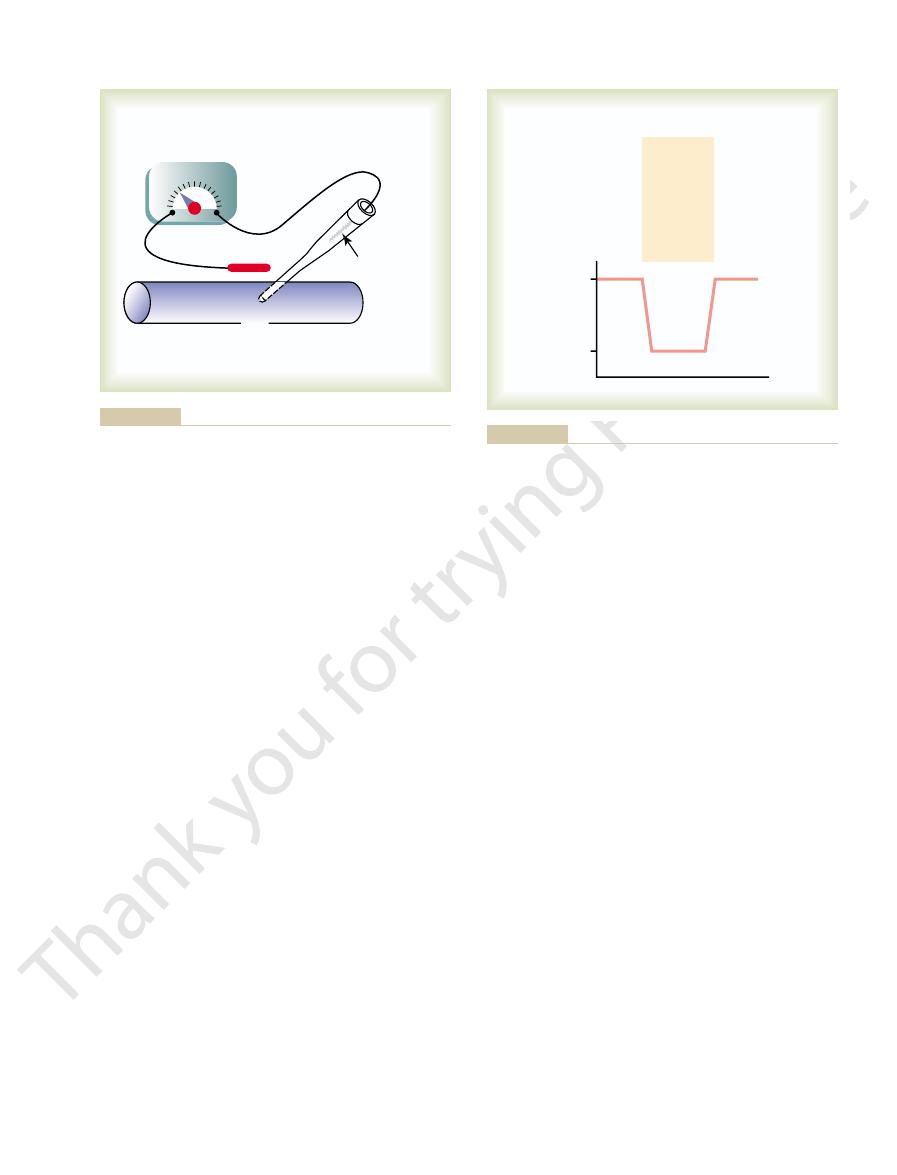
negative potential inside the cell membrane.
cit of positive ions on the inside; this causes a
ions to the inside), leaving a
4. Further, note that this is an
Figure 5
ions to the inside, as illustrated on the left-hand side in
First, let
Active Transport of Sodium and Potassium Ions Through the
the level of this resting potential, but before doing so,
paragraphs, we explain all the factors that determine
ber. In the next few
millivolts. That is, the potential
The resting membrane potential of large nerve
of Nerves
quent sections of this chapter.
as 1/10,000 of a second. Rapid shifting of ions in this
ber needs to be transferred. Also, an
ber; this means that only
3. Therefore, an incredibly small
panel of Figure 5
can be both positive and negative, as shown in the upper
outward. All the remaining ions inside the nerve
To create a negative potential inside the membrane,
ber.
ber,
90 millivolts. Moving across the center of the
), the potential decreases abruptly
electrical dipole layer
Then, as the recording electrode passes through the
is zero, which is the potential of the extracellular
is outside the nerve membrane, the recorded potential
gure and passing to the right. As long as the electrode
ber membrane, beginning at the left side of the
The lower part of Figure 5
chapter.
connected to an oscilloscope, as explained later in the
transmission of nerve impulses, the microelectrode is
changes
and a resistance more than a million ohms. For record-
ow through the tip of the micropipette, which
ate voltmeter. This voltmeter is a highly sophisticated
uid, and the potential difference between the inside
indifferent electrode,
ber. Then another electrode, called
lled with an electrolyte solution. The
bers. Figure 5
Membrane Potentials and Action Potentials
Chapter 5
59
of the small size of most of the fi
–2 shows
a small pipette fi
pipette is impaled through the cell membrane to
the interior of the fi
the “
” is placed in the extracellular
fl
and outside of the fiber is measured using an appropri-
electronic apparatus that is capable of measuring very
small voltages despite extremely high resistance to elec-
trical fl
has a lumen diameter usually less than 1 micrometer
ing rapid
in the membrane potential during
–3 shows the electrical
potential that is measured at each point in or near the
nerve fi
fi
fluid.
voltage change area at the cell membrane (called the
to –
fi
the potential remains at a steady –90-millivolt level but
reverses back to zero the instant it passes through the
membrane on the opposite side of the fi
only enough positive ions to develop the electrical
dipole layer at the membrane itself must be transported
fiber
–
number of ions needs to be transferred through the
membrane to establish the normal “resting potential” of
–90 millivolts inside the nerve fi
about 1/3,000,000 to 1/100,000,000 of the total positive
charges inside the fi
equally small number of positive ions moving from
outside to inside the fiber can reverse the potential from
–90 millivolts to as much as
+35 millivolts within as little
manner causes the nerve signals discussed in subse-
Resting Membrane Potential
fibers
when not transmitting nerve signals is about –90
inside the fiber is 90
millivolts more negative than the potential in the extra-
cellular fluid on the outside of the fi
we must describe the transport properties of the resting
nerve membrane for sodium and potassium.
Membrane—The Sodium-Potassium (Na
+
-K
+
) Pump.
us recall from Chapter 4 that all cell membranes of the
body have a powerful Na
+
-K
+
that continually pumps
sodium ions to the outside of the cell and potassium
–
electrogenic
pump because more positive charges are pumped to
the outside than to the inside (three Na
+
ions to the
outside for each two K
+
net defi
+ + + + + + + + +
+ + + + + + + +
+ + + + + + + + + + +
+ + + + +
—
+
0
Silver–silver
chloride
electrode
KCI
– – – – – – – – –
– – – – – – –
(– 90
mV)
– – – – – – – – – –
– – – – –
a microelectrode.
Measurement of the membrane potential of the nerve fiber using
Figure 5–2
–90
Electrical potential
(millivolts)
0
– + – + – + – + – + – + – + –
+ – + + – – + – + – – + + – +
– + – + – + – + – + – + – + –
+ – + + – – + – + – – + + – +
– + – + – + – + – + – + – + –
+ – + + – – + – + – – + + – +
– + – + – + – + – + – + – + –
+ – + + – – + – + – – + + – +
– + – + – + – + – + – + – + –
+ – + + – – + – + – – + + – +
Nerve fiber
the fiber.
surface. The lower panel displays the abrupt changes in mem-
surface of the membrane and positive charges along the outside
cellular fluid surrounding a nerve fiber and in the fluid inside the
Figure 5–3
Distribution of positively and negatively charged ions in the extra-
fiber; note the alignment of negative charges along the inside
brane potential that occur at the membranes on the two sides of
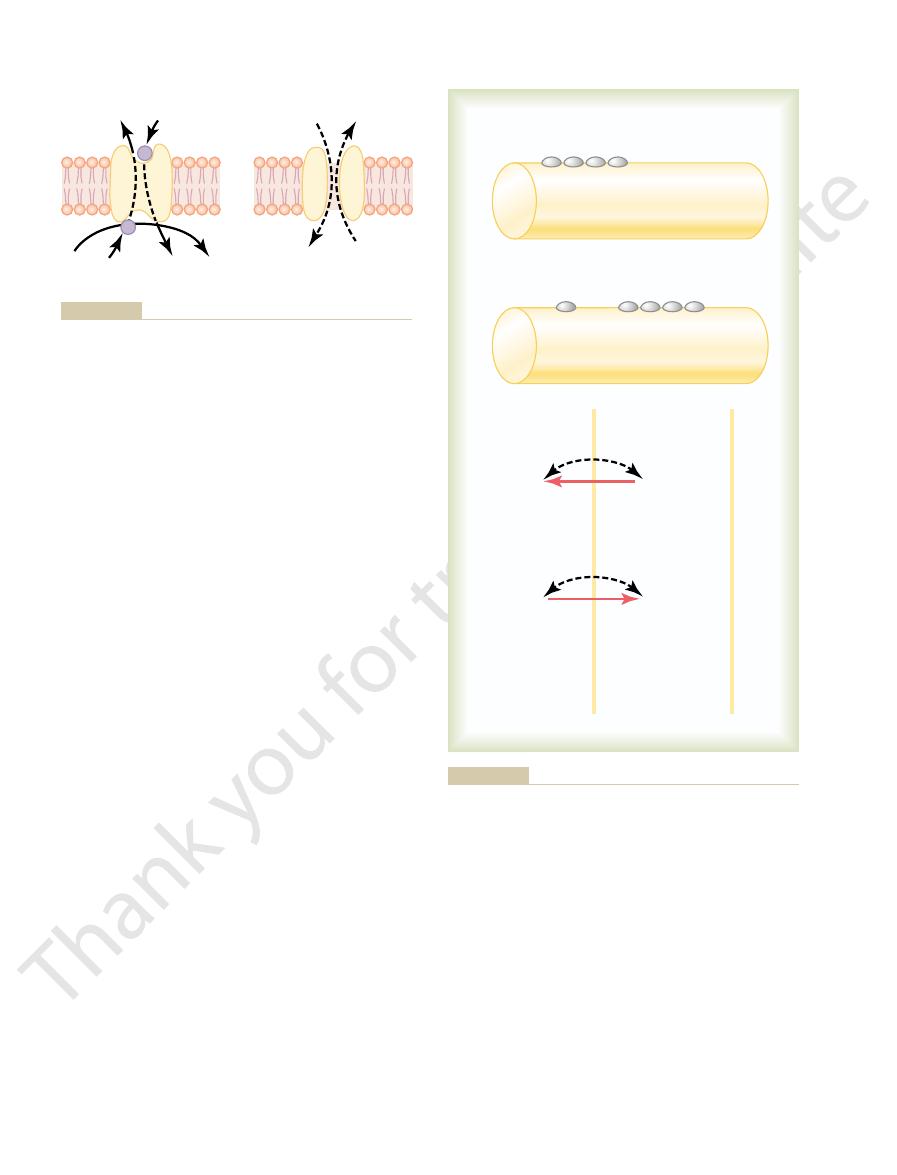
of the nerve membrane to sodium ions, caused by the
Figure 5
Contribution of Sodium Diffusion Through the Nerve Membrane.
gure.
millivolts, as shown in the
would be equal to
were the only factor causing the resting potential, the
94 millivolts. Therefore, if potassium ions
because the logarithm of 35 is 1.54, and this times
potassium ions inside to outside, 35:1, the Nernst
outside the membrane. Because of the high ratio of
potassium ions, as demonstrated by the open channels
In Figure
90 millivolts. They are as follows.
Figure 5
Origin of the Normal Resting
later, this differential in permeability is exceedingly
normally about 100 times as permeable. As discussed
potassium leakage because, on average, the channels
The emphasis is on
channel.
sium and sodium ions can leak, called a
The right side of Figure 5
Leakage of Potassium and Sodium Through the Nerve Mem-
The ratios of these two respective ions from the inside
(inside):
140 mEq/L
(outside):
4 mEq/L
(inside):
14 mEq/L
(outside):
142 mEq/L
membrane. These gradients are the following:
The Na
Membrane Physiology, Nerve, and Muscle
60
Unit II
+
-K
+
also causes large concentration gradi-
ents for sodium and potassium across the resting nerve
Na
+
Na
+
K
+
K
+
to the outside are
Na
+
inside
/Na
+
outside
= 0.1
K
+
inside
/K
+
outside
= 35.0
brane.
–4 shows a channel
protein in the nerve membrane through which potas-
potassium-
sodium (K
+
-Na
+
) “leak”
are far more permeable to potassium than to sodium,
important in determining the level of the normal
resting membrane potential.
Membrane Potential
–5 shows the important factors in the estab-
lishment of the normal resting membrane potential of
–
Contribution of the Potassium Diffusion Potential.
5–5A, we make the assumption that the only move-
ment of ions through the membrane is diffusion of
between the potassium symbols (K
+
) inside and
potential corresponding to this ratio is –94 millivolts
–61
millivolts is –
resting potential inside the fiber
–94
fi
–5B shows the addition of slight permeability
minute diffusion of sodium ions through the K
+
-Na
+
ATP
3Na
+
2K
+
Na
+
K
+
Na
+
K
+
Na
+
Na
+
-K
+
pump
K
+
-Na
+
"leak" channels
ADP
Outside
K
+
“leak” channels. ADP, adenosine diphosphate; ATP, adenosine
Figure 5–4
Functional characteristics of the Na
+
-K
+
pump and of the K
+
-Na
+
triphosphate.
Diffusion
Diffusion
4 mEq/L
140 mEq/L
142 mEq/L
4 mEq/L
142 mEq/L
14 mEq/L
+
+
+
+
+
+
+
+
-
-
-
-
-
-
-
-
+
+
+
+
+
+
-
-
-
-
-
-
+
+
+
+
+
+
+
+
+
+
+
+
+
+
+
+
+
+
+
-
-
-
-
-
-
-
-
-
-
-
-
-
-
-
-
-
-
-
(Anions)
-
(Anions)
-
(–90 mV)
Na
+
Na
+
K
+
4 mEq/L
K
+
Na
+
pump
A
B
C
K
+
K
+
pump
140 mEq/L
(
-
94 mV)
(–94 mV)
K
+
14 mEq/L
(
+
61 mV)
(–86 mV)
Na
+
140 mEq/L
(–94 mV)
K
+
when the membrane potential is caused by diffusion
potential is caused by diffusion of both sodium and potassium
entirely by potassium diffusion alone;
under three conditions:
Establishment of resting membrane potentials in nerve fibers
Figure 5–5
A, when the membrane potential is caused
B, when the membrane
ions; and C,
of both sodium and potassium ions plus pumping of both these
ions by the Na
+
-K
+
pump.
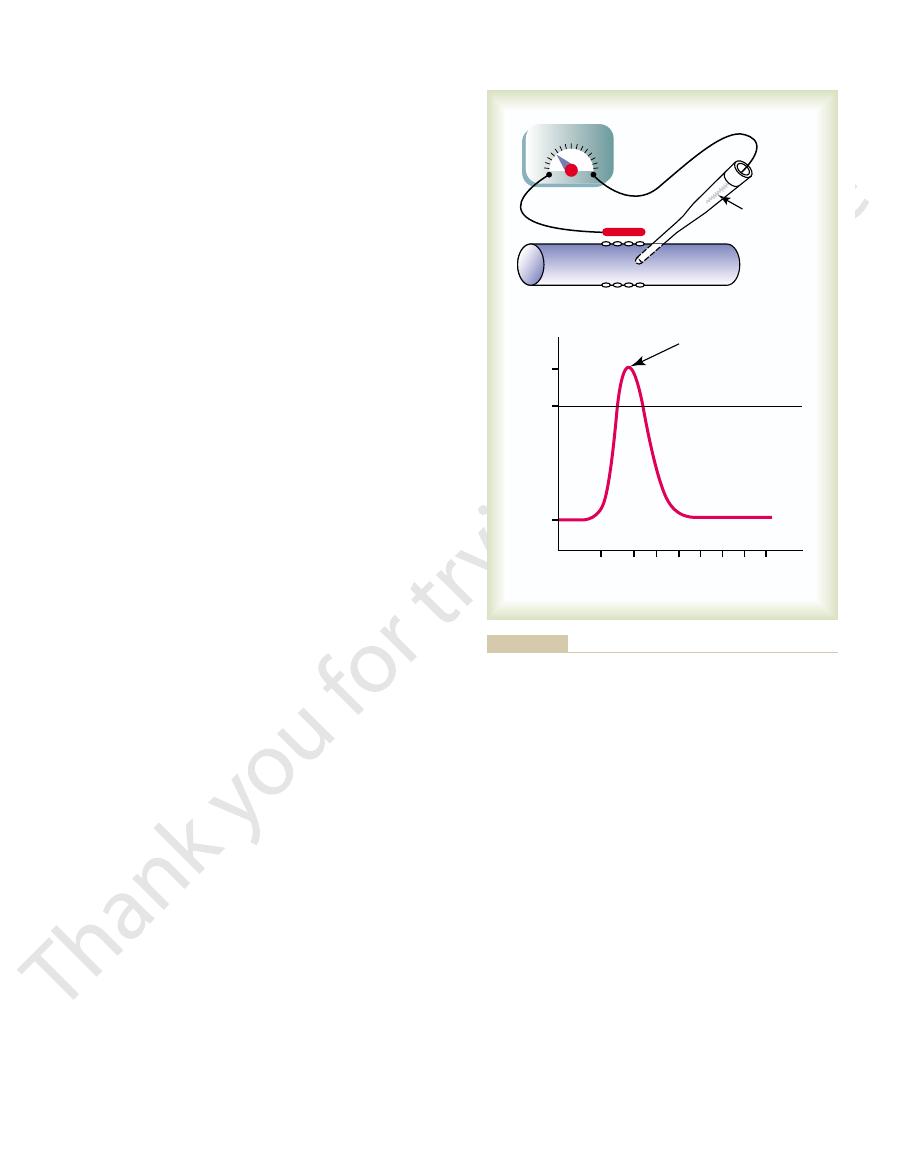
bers, as well as in
somewhat positive. In some smaller
bers, the great excess of positive sodium ions moving
In large nerve
direction. This is called
ions, with the potential rising rapidly in the positive
ions to diffuse to the interior of the axon. The normal
denly becomes very permeable to sodium ions, allow-
At this time, the membrane sud-
before the action potential begins. The membrane is
This is the resting membrane potential
follows.
The successive stages of the action potential are as
almost equally rapid recovery.
over a few 10,000ths of a second, illustrating the
the exterior at its end. The lower panel shows graphi-
tial, with transfer of positive charges to the interior of
The upper panel of Figure 5
To conduct a nerve signal, the action potential moves
ber membrane.
action potentials,
Nerve Action Potential
90 millivolts.
pump, giving a net membrane potential
this being determined by potassium diffusion. Then, an
86 millivolts, almost all of
In summary, the diffusion potentials alone caused by
90 millivolts.
diffusion alone. Therefore, as shown in Figure 5
from inside the membrane; this creates an additional
inside of the membrane. The fact that more sodium
gure, there
tribution to the resting potential. In this
, the
In Figure 5
gure.
86 millivolts, which is near
100 times as great as its permeability to sodium. Using
ber, the
the diffusion of sodium. In the normal nerve
sodium, it is logical that the diffusion of potassium con-
Intuitively, one can see that if the membrane is highly
by using the Goldman equation described previously.
will be the summated potential? This can be answered
volts. How do these interact with each other, and what
61 millivolts. But also shown in Figure 5
outside the membrane is 0.1, and this gives a calculated
leak channels. The ratio of sodium ions from inside to
Membrane Potentials and Action Potentials
Chapter 5
61
Nernst potential for the inside of the membrane of
+
–5B is the
Nernst potential for potassium diffusion of –94 milli-
permeable to potassium but only slightly permeable to
tributes far more to the membrane potential than does
fi
permeability of the membrane to potassium is about
this value in the Goldman equation gives a potential
inside the membrane of –
the potassium potential shown in the fi
Contribution of the Na
+
-K
+
Pump.
–5C
Na
+
-K
+
pump is shown to provide an additional con-
fi
is continuous pumping of three sodium ions to the
outside for each two potassium ions pumped to the
ions are being pumped to the outside than potassium
to the inside causes continual loss of positive charges
degree of negativity (about –4 millivolts additional) on
the inside beyond that which can be accounted for by
–5C,
the net membrane potential with all these factors
operative at the same time is about –
potassium and sodium diffusion would give a mem-
brane potential of about –
additional –4 millivolts is contributed to the mem-
brane potential by the continuously acting electro-
genic Na
+
-K
+
of –
Nerve signals are transmitted by
which are rapid changes in the membrane potential
that spread rapidly along the nerve fi
Each action potential begins with a sudden change
from the normal resting negative membrane potential
to a positive potential and then ends with an almost
equally rapid change back to the negative potential.
along the nerve fiber until it comes to the fiber’s
end.
–6 shows the changes
that occur at the membrane during the action poten-
the fiber at its onset and return of positive charges to
cally the successive changes in membrane potential
explosive onset of the action potential and the
Resting Stage.
said to be “polarized” during this stage because of the
–90 millivolts negative membrane potential that is
present.
Depolarization Stage.
ing tremendous numbers of positively charged sodium
“polarized” state of –90 millivolts is immediately neu-
tralized by the inflowing positively charged sodium
depolarization.
fi
to the inside causes the membrane potential to actu-
ally “overshoot” beyond the zero level and to become
fi
KCI
+ + + +
+ + + + + +
0.1 0.2 0.3 0.4 0.5 0.6 0.7
0
+35
0
–90
Millivolts
Overshoot
Milliseconds
D
e
p
o
la
ri
z
a
t
io
n
R
e
p
o
la
riz
a
tio
n
Resting
—
+
0
+ + + + +
Silver–silver
chloride
electrode
+ + + + – – – – – –
– – – –
– – – –
+ + + +
+ + + +
– – – – –
– – – –
– – – –
upper panel of the figure.
Typical action potential recorded by the method shown in the
Figure 5–6
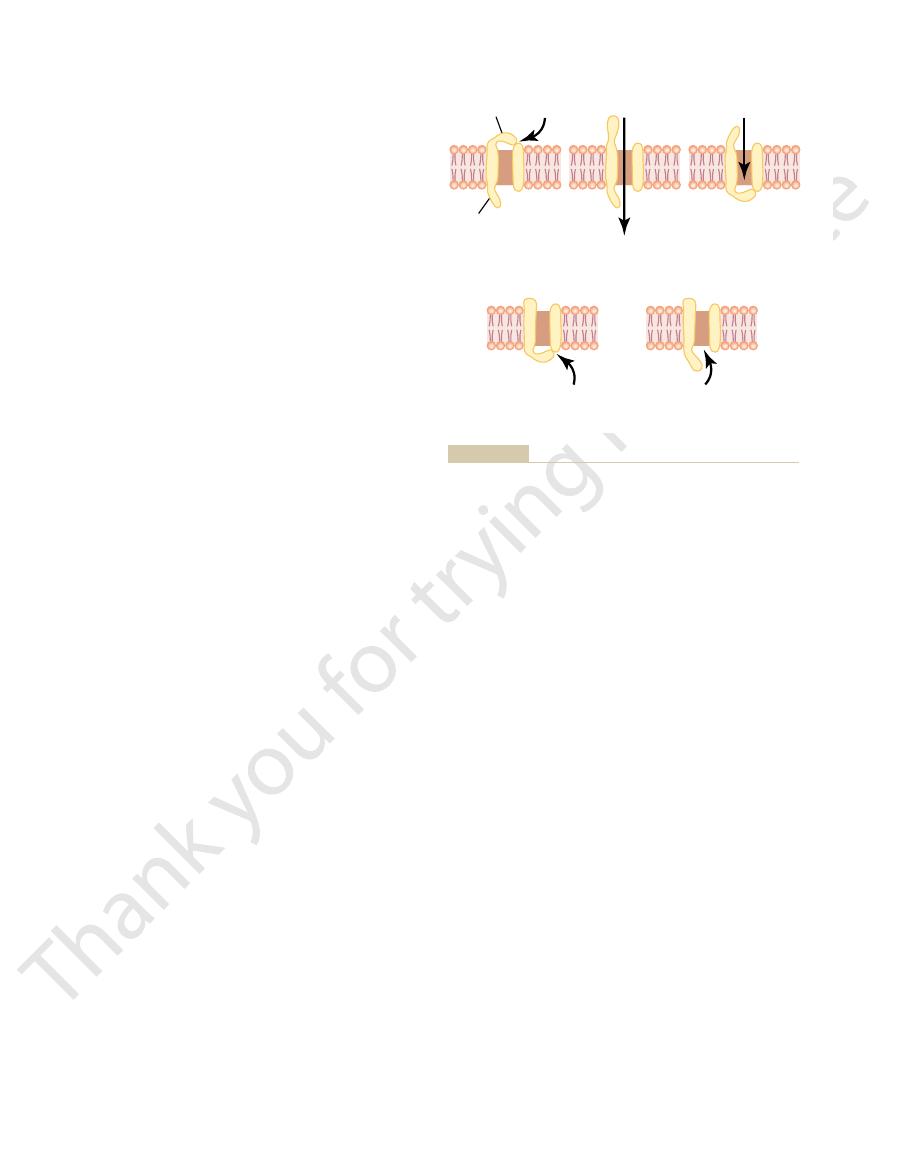
opening of the potassium channels, for the most part,
channel. However, because of the slight delay in
90 millivolts toward zero, this voltage change causes
exterior. When the membrane potential rises from
sium channel is closed, and potassium ions are pre-
(right). During the resting state, the gate of the potas-
potassium channel in two states: during the resting
The lower panel of Figure 5
Voltage-Gated Potassium Channel and
rst repolarizing.
potential level. Therefore, it usually is not possible for
membrane state, which is the repolarization process.
inside of the membrane. At this point, the membrane
gate closes, and sodium ions no longer can pour to the
open for a few 10,000ths of a second, the inactivation
Therefore, after the sodium channel has remained
formational change that opens the activation gate.
a second after the activation gate opens. That is, the
inactivation gate, however, closes a few 10,000ths of
activation gate also closes the inactivation gate. The
channel. The same increase in voltage that opens the
of Figure 5
The upper right panel
inward through the channel, increasing the sodium
during this state, sodium ions can pour
the way to the open position. This is called the
mational change in the activation gate,
90 millivolts toward zero, it
resting state, rising from
When the membrane
ber through these sodium channels.
90 millivolts. In this state, the activation gate is closed,
The upper left of the
inactivation gate.
activation gate,
sodium channel in three separate states. This channel
The upper panel of Figure 5
Voltage-Gated Sodium Channel—Activation
channels.
These two voltage-gated channels are
the membrane.
voltage-gated potassium channel
voltage-gated sodium channel.
The necessary actor in causing both depolarization
Potassium Channels
Voltage-Gated Sodium and
voltage-gated sodium and potassium channels.
port channels through the nerve membrane: the
depolarization and repolarization, we need to describe
To explain more fully the factors that cause both
membrane.
brane potential. This is called
Then, rapid diffusion of potassium ions to the exterior
sodium ions, the sodium channels begin to close and
Within a few 10,000ths of a second
shoot to the positive state.
many central nervous system neurons, the potential
Membrane Physiology, Nerve, and Muscle
62
Unit II
merely approaches the zero level and does not over-
Repolarization Stage.
after the membrane becomes highly permeable to
the potassium channels open more than normal.
re-establishes the normal negative resting mem-
repolarization of the
the special characteristics of two other types of trans-
and repolarization of the nerve membrane during the
action potential is the
A
also plays an impor-
tant role in increasing the rapidity of repolarization of
in addition to the Na
+
-K
+
pump and the K
+
-Na
+
leak
and Inactivation of the Channel
–7 shows the voltage-gated
has two gates—one near the outside of the channel
called the
and another near the inside
called the
figure
depicts the state of these two gates in the normal
resting membrane when the membrane potential is
–
which prevents any entry of sodium ions to the inte-
rior of the fi
Activation of the Sodium Channel.
potential becomes less negative than during the
–
finally reaches a voltage—usually somewhere between
–70 and –50 millivolts—that causes a sudden confor-
flipping it all
acti-
vated state;
permeability of the membrane as much as 500- to
5000-fold.
Inactivation of the Sodium Channel.
–7 shows a third state of the sodium
conformational change that flips the inactivation gate
to the closed state is a slower process than the con-
potential begins to recover back toward the resting
Another important characteristic of the sodium
channel inactivation process is that the inactivation
gate will not reopen until the membrane potential
returns to or near the original resting membrane
the sodium channels to open again without the nerve
fiber’s fi
Its Activation
–7 shows the voltage-gated
state (left) and toward the end of the action potential
vented from passing through this channel to the
–
a conformational opening of the gate and allows
increased potassium diffusion outward through the
90 mV,
Activation
gate
Inactivation
gate
Inside
Resting
(
-
90 mV)
Activated
(
-
90 to
+
35 mV)
Inactivated
(
+
35 to
-
delayed)
Resting
(
-
90 mV)
Slow activation
(
+
35 to
-
90 mV)
Na
+
Na
+
K
+
K
+
Na
+
normal resting negative value to a positive value.
sium channels when the membrane potential is changed from the
Figure 5–7
Characteristics of the voltage-gated sodium (top) and potassium
(bottom) channels, showing successive activation and inactiva-
tion of the sodium channels and delayed activation of the potas-
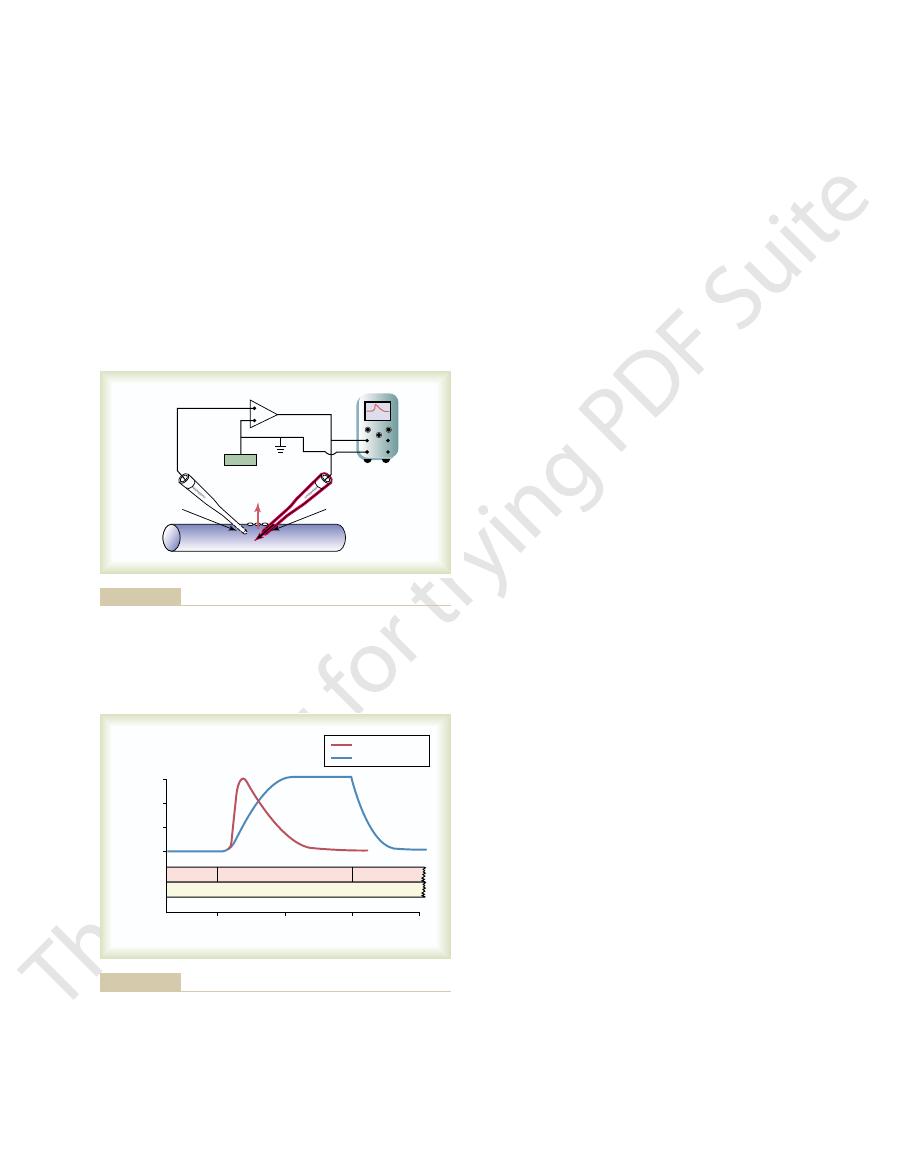
value.
closed. Further, once the potassium channels open, they
nels. These open slowly and reach their full open state
tive value. However, during the next millisecond or so,
90 millivolts.
and then, 2 milliseconds later, back to
Figure 5
ber.
activation gates are located. Conversely,
tetrodotoxin
channel at a time. For instance, the sodium channels can
potassium is the only permeant ion, current
ow only through the sodium channels. When
and outside the squid axon, the voltage clamp measures
some cases is as large as 1 millimeter in diameter. When
crustaceans, especially the giant squid axon, which in
easily when using large nerve
ber and repeats the study. This can be done
8. Finally, the
the screen of the oscilloscope in Figure 5
ow, as demonstrated on
instant, the current electrode is connected to an oscillo-
ow through the membrane channels. To
steady zero level. To achieve this, the current injected
cellular voltage, electrical current is injected automati-
through the channels. To counterbalance the effect of
open, and sodium and potassium ions begin to pour
zero, the voltage-gated sodium and potassium channels
the operator. When the membrane potential is suddenly
as measured by the voltage electrode, at the level set by
trode at whatever rate is required to hold the voltage,
the desired voltage, and this automatically injects either
ber. The
following way: The investigator decides which voltage
ber. This apparatus is used in the
tial, and the other is to conduct electrical current into
ber. One of
through the different channels. In using this apparatus,
voltage clamp,
Figure 5
these studies is shown in Figures 5
entists responsible, Hodgkin and Huxley. The essence of
The original research that led to quantitative
and Closing of the Voltage-Gated Channels—The “Voltage
Research Method for Measuring the Effect of Voltage on Opening
combine to speed the repolarization process, leading
Thus, the decrease in sodium entry to the cell and the
Membrane Potentials and Action Potentials
Chapter 5
63
they open just at the same time that the sodium chan-
nels are beginning to close because of inactivation.
simultaneous increase in potassium exit from the cell
to full recovery of the resting membrane potential
within another few 10,000ths of a second.
Clamp.”
understanding of the sodium and potassium channels
was so ingenious that it led to Nobel Prizes for the sci-
–8 and 5–9.
–8 shows an experimental apparatus called a
which is used to measure flow of ions
two electrodes are inserted into the nerve fi
these is to measure the voltage of the membrane poten-
or out of the nerve fi
he or she wants to establish inside the nerve fi
electronic portion of the apparatus is then adjusted to
positive or negative electricity through the current elec-
increased by this voltage clamp from –90 millivolts to
these ion movements on the desired setting of the intra-
cally through the current electrode of the voltage clamp
to maintain the intracellular voltage at the required
must be equal to but of opposite polarity to the net
current fl
measure how much current flow is occurring at each
scope that records the current fl
–
investigator adjusts the concentrations of the ions to
other than normal levels both inside and outside the
nerve fi
fibers removed from some
sodium is the only permeant ion in the solutions inside
current fl
flow only
through the potassium channels is measured.
Another means for studying the flow of ions through
an individual type of channel is to block one type of
be blocked by a toxin called
by applying it
to the outside of the cell membrane where the sodium
tetraethylam-
monium ion blocks the potassium channels when it is
applied to the interior of the nerve fi
–9 shows typical changes in conductance of
the voltage-gated sodium and potassium channels when
the membrane potential is suddenly changed by use of
the voltage clamp from –90 millivolts to
+10 millivolts
–
Note the sudden opening of the sodium channels (the
activation stage) within a small fraction of a millisecond
after the membrane potential is increased to the posi-
the sodium channels automatically close (the inactiva-
tion stage).
Note the opening (activation) of the potassium chan-
only after the sodium channels have almost completely
remain open for the entire duration of the positive
membrane potential and do not close again until after
the membrane potential is decreased back to a negative
Current
electrode
Voltage
electrode
Amplifier
Electrode
in fluid
“Voltage clamp” method for studying flow of ions through specific
Figure 5–8
channels.
90 mV
+10 mV
0
1
2
3
(mmho
/cm
Conductance
2
)
Time (milliseconds)
20
10
0
30
–
– 90 mV
Membrane potential
Activation
In
ac
tiva
t
Na
+
channel
K
+
channel
before the end of the 2 milliseconds, whereas the potassium chan-
10 millivolts for 2 milliseconds. This figure shows that the
from the normal resting value of –90 millivolts to a positive value
channels when the membrane potential is suddenly increased
Typical changes in conductance of sodium and potassium ion
Figure 5–9
of
+
sodium channels open (activate) and then close (inactivate)
nels only open (activate), and the rate of opening is much slower
than that of the sodium channels.
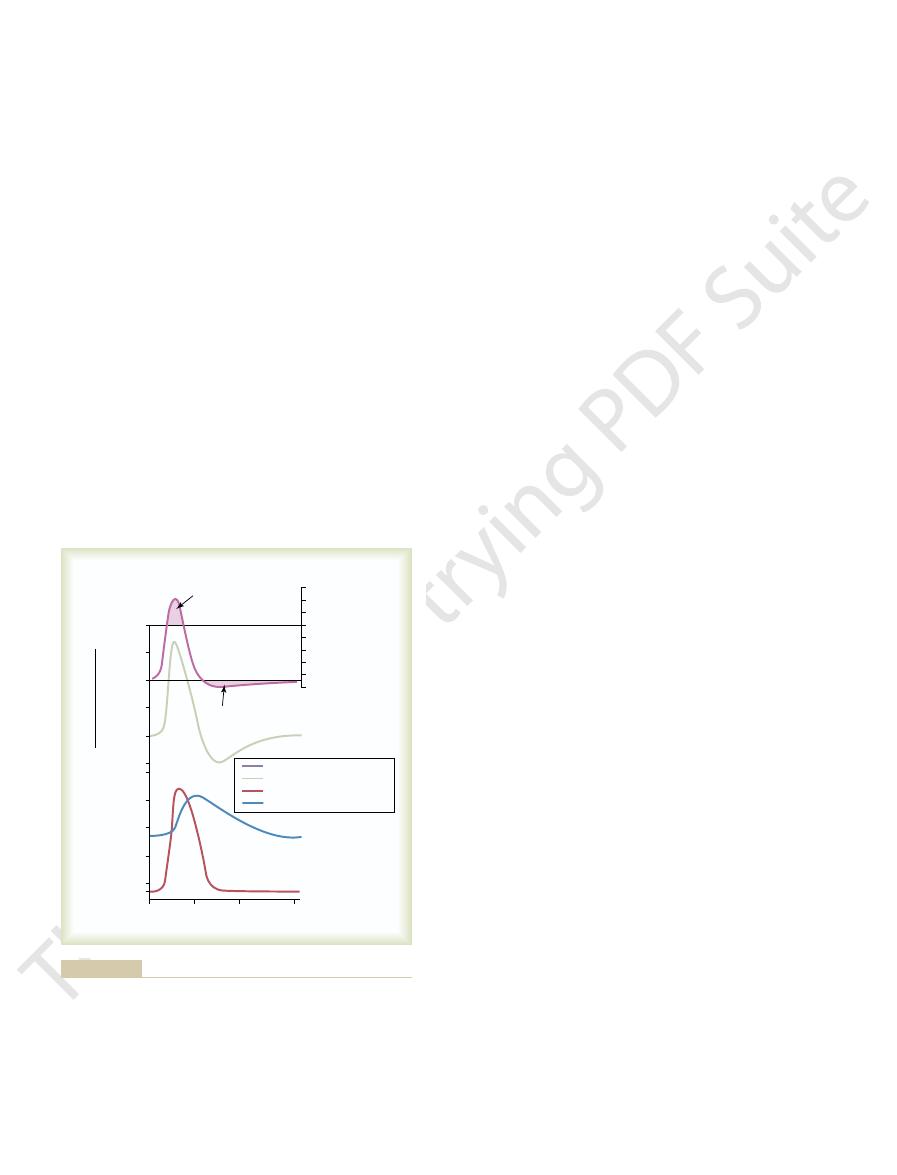
smooth muscle, the fast sodium channels are hardly
muscle and smooth muscle. In fact, in some types of
fast channels.
in contrast to the sodium channels, which are called
nels,
slow chan-
sodium channels. Therefore, they are called
The calcium channels are slow to become activated,
channels.
fore, these channels are also called
ber. There-
well as to calcium ions; when they open, both calcium
These channels are slightly permeable to sodium ions as
In addition, there are voltage-gated calcium channels.
molar.
molar, in contrast to an external con-
This leaves an internal cell concentration of calcium
the sodium pump, the calcium pump pumps calcium
some cells to cause most of the action potential. Like
body have a calcium pump similar to the sodium pump,
The membranes of almost all cells of the
sium ions and other positive ions.
anions. Therefore, these impermeant negative ions are
the axon, any de
so forth. Because these ions cannot leave the interior of
organic phosphate compounds, sulfate compounds, and
that cannot go through the membrane channels. They
Impermeant Negatively Charged Ions (Anions) Inside the Nerve
sidered: negative anions and calcium ions.
potential. At least two other types of ions must be con-
Thus far, we have considered only the roles of sodium
sodium ions to the interior. Consequently, the action
conductance. This allows very rapid loss of potassium
open, so that the ratio of conductance shifts far in
positive at the action potential onset. Then the sodium
ber than do potassium ions to the exterior. This
Therefore, far more sodium ions
of the action potential, the ratio of sodium to potas-
is the action potential itself. During the early portion
each instant during the action potential, and above this
The middle portion of Figure 5
an additional millisecond or more delay.
close back to their original status, but again, only after
action potential, the return of the membrane potential
ond after the sodium channels open. At the end of the
voltage gating of the potassium channels, causing them
ond. The onset of the action potential also causes
ductance. Then the inactivation process closes the
However, at the onset of the action potential, the
sium ions than sodium ions through the leak channels.
ions. This is caused by much greater leakage of potas-
potential begins, the conductance for potassium ions is
ions. During the resting state, before the action
potential. The bottom of the
Figure 5
the Action Potential
Membrane Physiology, Nerve, and Muscle
64
Unit II
Summary of the Events That Cause
–10 shows in summary form the sequential
events that occur during and shortly after the action
figure shows the changes
in membrane conductance for sodium and potassium
50 to 100 times as great as the conductance for sodium
sodium channels instantaneously become activated
and allow up to a 5000-fold increase in sodium con-
sodium channels within another fraction of a millisec-
to begin opening more slowly a fraction of a millisec-
to the negative state causes the potassium channels to
–10 shows the ratio
of sodium conductance to potassium conductance at
sium conductance increases more than 1000-fold.
flow to the interior of
the fi
is what causes the membrane potential to become
channels begin to close and the potassium channels to
favor of high potassium conductance but low sodium
ions to the exterior but virtually zero flow of
potential quickly returns to its baseline level.
Roles of Other Ions During
the Action Potential
and potassium ions in the generation of the action
Axon.
Inside the axon are many negatively charged ions
include the anions of protein molecules and of many
ficit of positive ions inside the mem-
brane leaves an excess of these impermeant negative
responsible for the negative charge inside the fiber
when there is a net deficit of positively charged potas-
Calcium Ions.
and calcium serves along with (or instead of) sodium in
ions from the interior to the exterior of the cell mem-
brane (or into the endoplasmic reticulum of the cell),
creating a calcium ion gradient of about 10,000-fold.
ions of about 10
–7
centration of about 10
–3
and sodium ions flow to the interior of the fi
Ca
++
-Na
+
requiring 10 to 20 times as long for activation as the
Calcium channels are numerous in both cardiac
+ 20
+ 40
+ 60
0
1.5
(mmho
/cm
Conductance
2
)
Na
+
conductance
K
+
conductance
Milliseconds
0.5
1.0
0.1
0.01
0.005
1
10
100
0.001
0.01
0.1
1
10
100
Overshoot
Positive
afterpotential
0
– 20
– 40
– 60
– 80
–100
Membrane potential (mV)
Action potential
Ratio of conductances
Na
+
K
+
sented in papers by Hodgkin and Huxley but transposed from
period thereafter. (These curves were constructed from theory pre-
during the latter stages of the action potential and for a short
tial, whereas potassium conductance increases only about 30-fold
course of the action potential. Sodium conductance increases
Figure 5–10
Changes in sodium and potassium conductance during the
several thousand-fold during the early stages of the action poten-
squid axon to apply to the membrane potentials of large mam-
malian nerve fibers.)
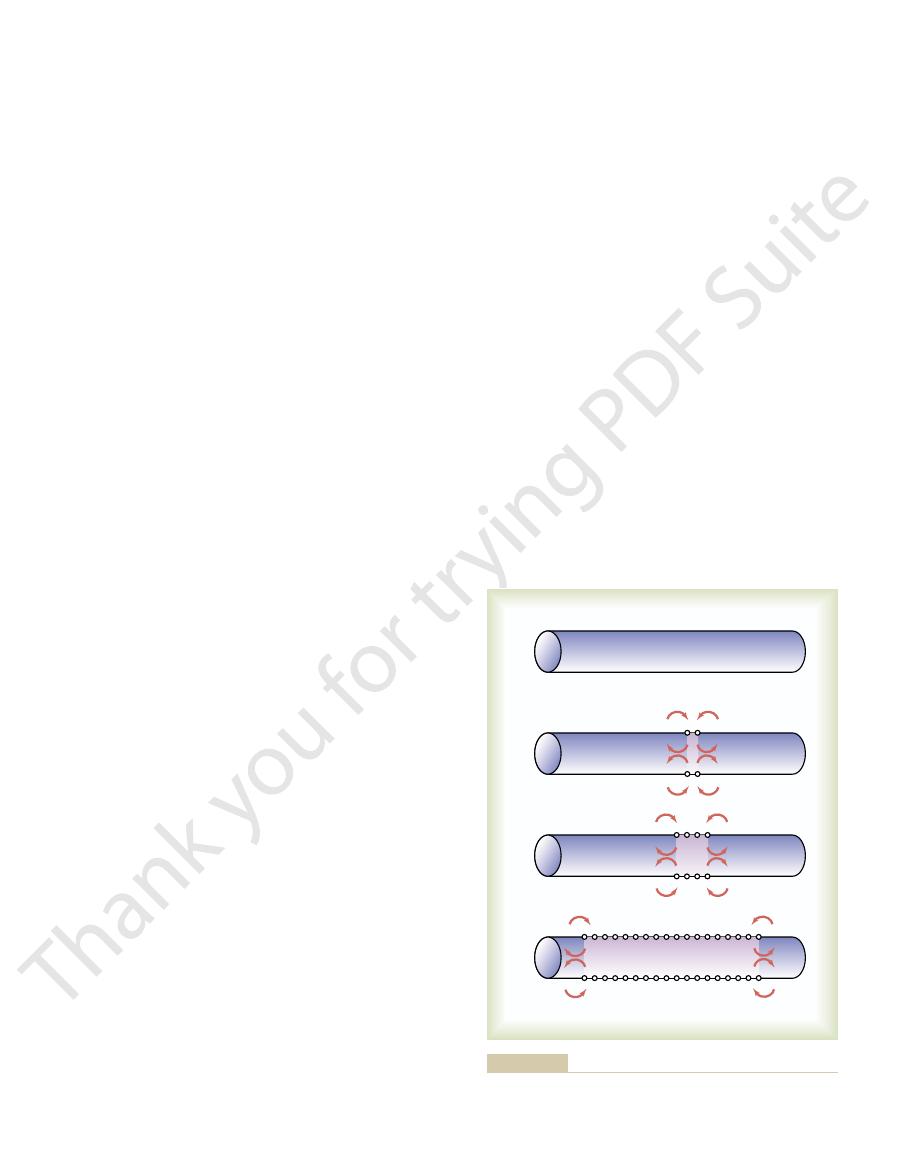
These positive charges increase the voltage for a dis-
brane areas. That is, positive electrical charges are
increased permeability to sodium. The arrows show a
that is, the midportion suddenly develops
ber, and Figure 5
11. Figure 5
nism is demonstrated in Figure 5
the action potential along the membrane. This mecha-
portions of the membrane, resulting in propagation of
However, an action potential elicited at any one point
potential as it occurs at one spot on the membrane.
In the preceding paragraphs, we discussed the action
Propagation of the
potential. This level of
to 30 millivolts usually is required. Therefore, a sudden
ber. A sudden rise in membrane potential of 15
cycle described in the preceding paragraph. This
tial soon terminates.
opening of potassium channels, and the action poten-
tion of a millisecond, the rising membrane potential
become activated (opened). Then, within another frac-
cycle that, once the feedback is strong enough, contin-
ber. This process is a positive-feedback vicious
causes a further rise in the membrane potential, thus
ow of sodium ions, which
opening. This allows rapid in
volts toward the zero level, the rising voltage itself
normal nerve. However, if any event causes enough
remains undisturbed, no action potential occurs in the
First, as long as the membrane of the nerve
action potential. The answer is quite simple.
itself, but we have not explained what initiates the
sodium and potassium permeability of the membrane,
Up to this point, we have explained the changing
Initiation of the Action Potential
open the sodium gate.
itself, in this way altering the voltage level required to
molecule. The positive charges of these calcium ions
sodium channels is as follows: These ions appear to bind
The probable way in which calcium ions affect the
respiratory muscles.
This is
tetany.
peripheral nerves, often causing muscle
remaining in the resting state. In fact, the calcium ion
ber becomes highly excitable, sometimes dis-
tial from its normal, very negative level. Therefore, the
calcium ions, the sodium channels become activated
channels become activated. When there is a de
The concentration of
entirely by activation of slow calcium channels.
present, so that the action potentials are caused almost
Membrane Potentials and Action Potentials
Chapter 5
65
Increased Permeability of the Sodium Channels When
There Is a Deficit of Calcium Ions.
calcium ions in the extracellular fluid also has a pro-
found effect on the voltage level at which the sodium
ficit of
(opened) by very little increase of the membrane poten-
nerve fi
charging repetitively without provocation rather than
concentration needs to fall only 50 per cent below
normal before spontaneous discharge occurs in some
“
”
sometimes lethal because of tetanic contraction of the
to the exterior surfaces of the sodium channel protein
in turn alter the electrical state of the channel protein
as well as the development of the action potential
A Positive-Feedback Vicious Cycle Opens the Sodium Channels.
fiber
initial rise in the membrane potential from –90 milli-
causes many voltage-gated sodium channels to begin
fl
opening still more voltage-gated sodium channels and
allowing more streaming of sodium ions to the interior
of the fi
ues until all the voltage-gated sodium channels have
causes closure of the sodium channels as well as
Threshold for Initiation of the Action Potential.
An action
potential will not occur until the initial rise in mem-
brane potential is great enough to create the vicious
occurs when the number of Na
+
ions entering the fiber
becomes greater than the number of K
+
ions leaving
the fi
increase in the membrane potential in a large nerve
fiber from –90 millivolts up to about –65 millivolts
usually causes the explosive development of an action
–65 millivolts is said to be the
threshold for stimulation.
Action Potential
on an excitable membrane usually excites adjacent
–
–11A
shows a normal resting nerve fi
–11B
shows a nerve fiber that has been excited in its mid-
portion—
“local circuit” of current flow from the depolarized
areas of the membrane to the adjacent resting mem-
carried by the inward-diffusing sodium ions through
the depolarized membrane and then for several mil-
limeters in both directions along the core of the axon.
tance of 1 to 3 millimeters inside the large myelinated
+ + + +
+ + + + + + + + + + + + + + + + + + + + + + +
+ + + + + + + + + + + + + + + + + + + + + + +
+ +
+ + + + + + + + + + + + + + + + + +
+ + + + + + + + + + + + + + + + + +
+ + + + + + + + +
+ + + + + + + + + + + +
+ + + + + + + + +
+ + + + + + + + + + + + – –
– –
+ + + + + + + + + + – – – – + + + + + + + +
+ + + + + + + + + + – – – – + + + + + + + +
– –
– –
– –
– –
+ + – – – – – – – – – – – – – – – – – – + +
+ + – – – – – – – – – – – – – – – – – –
– – – – – – – – – – – – + + – – – – – – – – –
– – – – – – – – – – – – – – – – – – – – – – –
– – – – – – – – – – – – – – – – – – – – – – –
– – – – – – – – – – – – + + – – – – – – – – –
– – – – – – – – – – + + + + – – – – – – – –
– – – – – – – – – –
– – – – – – – –
A
B
C
D
ductive fiber.
Propagation of action potentials in both directions along a con-
Figure 5–11

factors. First, in heart muscle, two types of channels
The cause of the plateau is a combination of several
bers,
greatly prolongs the period of depolarization. This
13; one can readily see that the plateau
in Figure 5
does repolarization begin. Such a plateau is shown
spike potential for many milliseconds, and only then
repolarize immediately after depolarization; instead,
In some instances, the excited membrane does not
ber can be
about eightfold. Therefore, it is easy to understand
concentration rises from 10 to 20 mEq/L, the activity
sodium concentration. That is, as the internal sodium
fact, the pumping activity increases approximately in
sodium ions accumulate inside the cell membrane. In
ATPase pump is that
when the nerve impulse frequency increases.
recharging, which is a measure of energy expenditure
12 shows
(ATP) energy system of the cell. Figure 5
ber is an active metabolic process, using
pump requires energy for operation, this
pump. Because this
is, sodium ions that have diffused to the interior of the
the original establishment of the resting potential.That
This is achieved by action of the Na
and potassium membrane concentration differences.
time, it becomes necessary to re-establish the sodium
that action potential conduction ceases. Even so, with
it cannot be measured. Indeed, 100,000 to 50 million
single action potential, this effect is so minute that
diffuse to the outside during repolarization. For a
outside the membrane, because sodium ions diffuse to
The transmission of each action potential along a
of Energy Metabolism
Completed—Importance
After Action Potentials Are
greater than 1
greater than 1. This
gation of an impulse to occur, the ratio of action poten-
depolarization stops. Therefore, for continued propa-
of the membrane. When this occurs, the spread of
excitable tissues. Occasionally, the action potential
all-or-nothing principle,
not travel at all if conditions are not right. This is called
the entire membrane if conditions are right, or it does
ber, the depolarization process travels over
All-or-Nothing Principle.
of propagation, but the action potential travels in all
11, an excitable membrane has no single direction
As demonstrated in Figure
muscle impulse.
ber. This trans-
depolarization. Thus, the depolarization process
the membrane, causing progressively more and more
tial spreads. These newly depolarized areas produce
Figure 5
in these new areas immediately open, as shown in
ing an action potential. Therefore, the sodium channels
Membrane Physiology, Nerve, and Muscle
66
Unit II
fiber to above the threshold voltage value for initiat-
–11C and D, and the explosive action poten-
still more local circuits of current flow farther along
travels along the entire length of the fi
mission of the depolarization process along a nerve or
muscle fiber is called a nerve or
Direction of Propagation.
5–
directions away from the stimulus—even along all
branches of a nerve fiber—until the entire membrane
has become depolarized.
Once an action potential has
been elicited at any point on the membrane of a
normal fi
the
and it applies to all normal
reaches a point on the membrane at which it does not
generate sufficient voltage to stimulate the next area
tial to threshold for excitation must at all times be
“
” requirement is
called the safety factor for propagation.
Re-establishing Sodium and
Potassium Ionic Gradients
nerve fiber reduces very slightly the concentration
differences of sodium and potassium inside and
the inside during depolarization and potassium ions
impulses can be transmitted by large nerve fibers
before the concentration differences reach the point
+
-K
+
pump in the
same way as described previously in the chapter for
cell during the action potentials and potassium ions
that have diffused to the exterior must be returned to
their original state by the Na
+
-K
+
“recharging”
of the nerve fi
energy derived from the adenosine triphosphate
–
that the nerve fiber produces excess heat during
A special feature of the Na
+
-K
+
its degree of activity is strongly stimulated when excess
proportion to the third power of this intracellular
of the pump does not merely double but increases
how the “recharging” process of the nerve fi
set rapidly into motion whenever the concentration
differences of sodium and potassium ions across the
membrane begin to “run down.”
Plateau in Some Action
Potentials
the potential remains on a plateau near the peak of the
–
type of action potential occurs in heart muscle fi
where the plateau lasts for as long as 0.2 to 0.3 second
and causes contraction of heart muscle to last for this
same long period.
0
100
200
300
Heat production
Impulses per second
At rest
increasing rates of stimulation.
Heat production in a nerve fiber at rest and at progressively
Figure 5–12

becomes excessively permeable to potassium ions. The
tinuing for a short period thereafter, the membrane
that toward the end of each action potential, and con-
14. This shows
in Figure 5
before the onset of the next action potential? The
polarized, rather than delaying for nearly a second
Why does the membrane of the heart control center
tissue.
neously. This cycle continues over and over and causes
tion again, and a new action potential occurs sponta-
seconds, spontaneous excitability causes depolariza-
polarizes. After another delay of milliseconds or
at the end of the action potential, the membrane re-
and so on, until an action potential is generated. Then,
ow inward; and (4) the permeability increases more,
increases membrane permeability; (3) still more ions
brane voltage in the positive direction, which further
ow inward; (2) this increases the mem-
the following sequence occurs: (1) some sodium and
sodium and calcium channels totally closed. Therefore,
volts. This is not enough negative voltage to keep the
14 shows
membrane depolarization. Thus, Figure 5
For spontaneous rhythmicity to occur, the membrane
Re-excitation Process Necessary for Spontaneous Rhythmicity.
permeability of the membrane.
below a critical value, both of which increase sodium
normally are highly stable, discharge repetitively when
bers, which
tissue cells is reduced low enough. For instance, even
Also, almost all other excitable tissues can discharge
breathing.
heart, (2) rhythmical peristalsis of the intestines, and
neurons of the central nervous system. These rhyth-
the heart, in most smooth muscle, and in many of the
EXCITABLE TISSUES—
90 millivolts.
very much until the end of the plateau. This delays the
nels are slower than usual to open, often not opening
ber,
spike portion of the action potential, whereas the slow,
slow channels.
nels, which are slow to open and therefore are called
nels,
fast chan-
voltage-activated sodium channels, called
enter into the depolarization process: (1) the usual
Membrane Potentials and Action Potentials
Chapter 5
67
and (2) voltage-activated calcium-sodium chan-
Opening of fast channels causes the
prolonged opening of the slow calcium-sodium chan-
nels mainly allows calcium ions to enter the fi
which is largely responsible for the plateau portion of
the action potential as well.
A second factor that may be partly responsible for
the plateau is that the voltage-gated potassium chan-
return of the membrane potential toward its normal
negative value of –80 to –
RHYTHMICITY OF SOME
REPETITIVE DISCHARGE
Repetitive self-induced discharges occur normally in
mical discharges cause (1) the rhythmical beat of the
(3) such neuronal events as the rhythmical control of
repetitively if the threshold for stimulation of the
large nerve fibers and skeletal muscle fi
they are placed in a solution that contains the drug
veratrine or when the calcium ion concentration falls
even in its natural state must be permeable enough to
sodium ions (or to calcium and sodium ions through
the slow calcium-sodium channels) to allow automatic
–
that the “resting” membrane potential in the rhythmi-
cal control center of the heart is only –60 to –70 milli-
calcium ions fl
fl
self-induced rhythmical excitation of the excitable
not depolarize immediately after it has become re-
answer can be found by observing the curve labeled
“potassium conductance”
–
excessive outflow of potassium ions carries tremen-
dous numbers of positive charges to the outside of the
0.9
0.8
0.7
0.6
0.5
0.4
0.3
0.2
0.1
0
+60
+40
+20
0
–20
–40
–60
–80
–100
Millivolts
Plateau
Seconds
Action potential (in millivolts) from a Purkinje fiber of the heart,
Figure 5–13
showing a “plateau.”
1
0
Seconds
2
3
+60
+40
+20
0
– 20
– 40
– 60
Millivolts
Potassium
conductance
Hyperpolarization
Rhythmical
action
potentials Threshold
in the rhythmical control center of the heart. Note their relationship
Rhythmical action potentials (in millivolts) similar to those recorded
Figure 5–14
to potassium conductance and to the state of hyperpolarization.
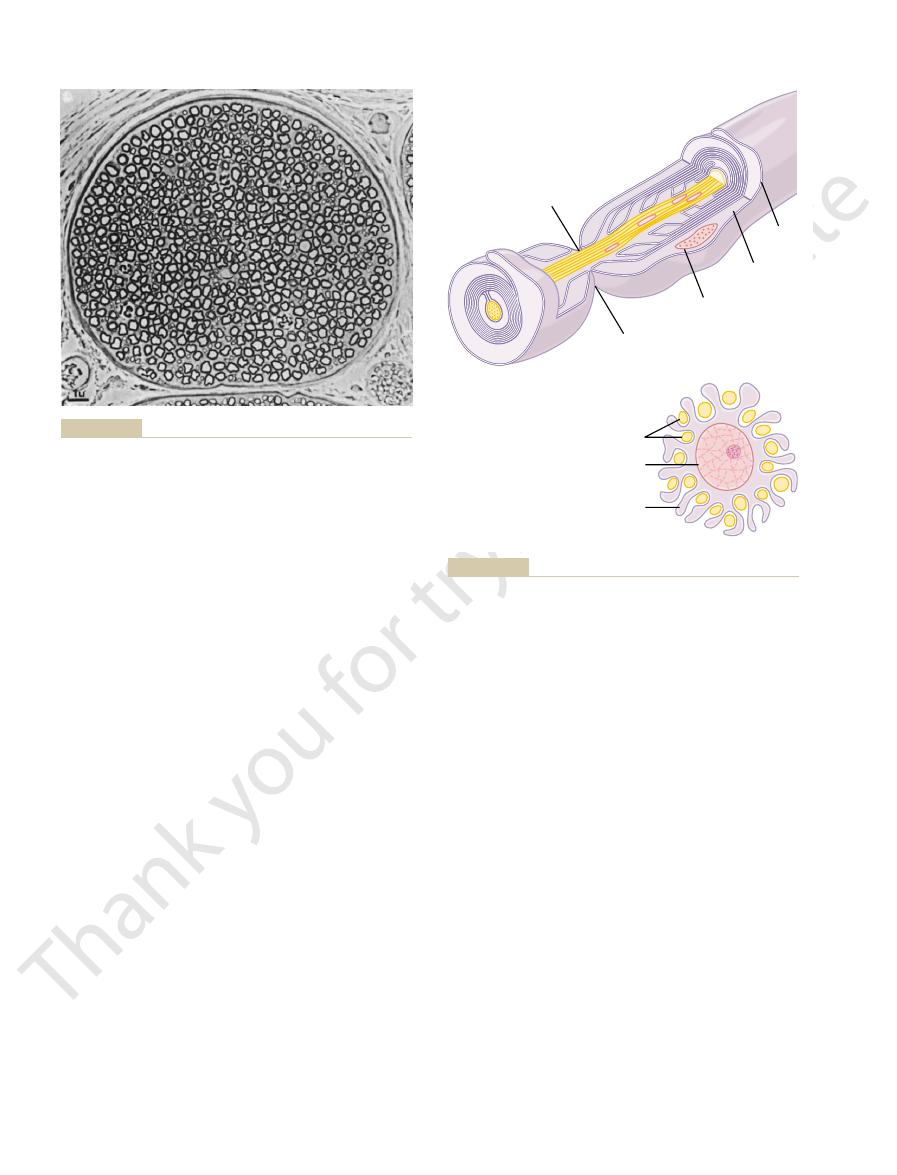
node, exciting successive nodes one after another. Thus,
That is,
17; this is called
Figure 5
tials are conducted from node to node, as shown in
Yet the action poten-
only at the nodes.
ease through the nodes of Ranvier. Therefore, action
myelin sheaths of myelinated nerves, they can
“Saltatory” Conduction in Myelinated Fibers from Node to Node.
node of Ranvier.
axon. This area is called the
along the axon, a small uninsulated area only 2 to 3
ow through the membrane about 5000-fold. At the
This sub-
Schwann cell rotates around the axon many times,
rst envelops the axon. Then the
Schwann cells in the following manner: The membrane
The myelin sheath is deposited around the axon by
of Ranvier.
than the axon itself. About once every 1 to 3 milli-
uid. Surrounding
action potential. The axon is
ber. The
Figure 5
bers.
The average nerve trunk
the large ones. The large
cross-sectional area. However, a more careful look
many large nerve
shows a cross section of a typical small nerve, revealing
Figure 5
Myelinated and Unmyelinated Nerve Fibers.
in Nerve Trunks
of Signal Transmission
suddenly, a new action potential results, and the
for excitation. Then,
gure, thereby allowing the membrane potential again
state of hyperpolarization) gradually disappears, as
occur. But the excess potassium conductance (and the
long as this state exists, self
14.As
also shown in Figure 5
nearer to the potassium Nernst potential.This is a state
tial is over, thus drawing the membrane potential
negativity than would otherwise occur. This continues
membrane, leaving inside the
Membrane Physiology, Nerve, and Muscle
68
Unit II
fiber considerably more
for nearly a second after the preceding action poten-
called hyperpolarization,
–
–re-excitation will not
shown after each action potential is completed in the
fi
to increase up to the threshold
process occurs again and again.
Special Characteristics
–15
fibers that constitute most of the
reveals many more very small fibers lying between
fibers are myelinated, and the
small ones are unmyelinated.
contains about twice as many unmyelinated fibers as
myelinated fi
–16 shows a typical myelinated fi
central core of the fiber is the axon, and the membrane
of the axon is the membrane that actually conducts the
filled in its center with axo-
plasm, which is a viscid intracellular fl
the axon is a myelin sheath that is often much thicker
meters along the length of the myelin sheath is a node
of a Schwann cell fi
laying down multiple layers of Schwann cell membrane
containing the lipid substance sphingomyelin.
stance is an excellent electrical insulator that decreases
ion fl
juncture between each two successive Schwann cells
micrometers in length remains where ions still can flow
with ease through the axon membrane between the
extracellular fluid and the intracellular fluid inside the
Even though almost no ions can flow through the thick
flow with
potentials occur
–
saltatory conduction.
electrical current flows through the surrounding extra-
cellular fluid outside the myelin sheath as well as
through the axoplasm inside the axon from node to
Cross section of a small nerve trunk containing both myelinated
Figure 5–15
and unmyelinated fibers.
Axon
A
B
Node of Ranvier
Unmyelinated axons
Schwann cell nucleus
Schwann cell cytoplasm
Schwann cell
nucleus
Schwann cell
cytoplasm
Myelin
sheath
from Leeson TS, Leeson R: Histology. Philadelphia: WB Saunders,
unmyelinated nerve fibers (shown in cross section). (
the membrane and cytoplasm of a Schwann cell around multiple
Partial wrapping of
myelin sheath of the myelinated nerve fiber.
of a Schwann cell membrane around a large axon to form the
Wrapping
Figure 5–16
Function of the Schwann cell to insulate nerve fibers. A,
B,
A, Modified
1979.)
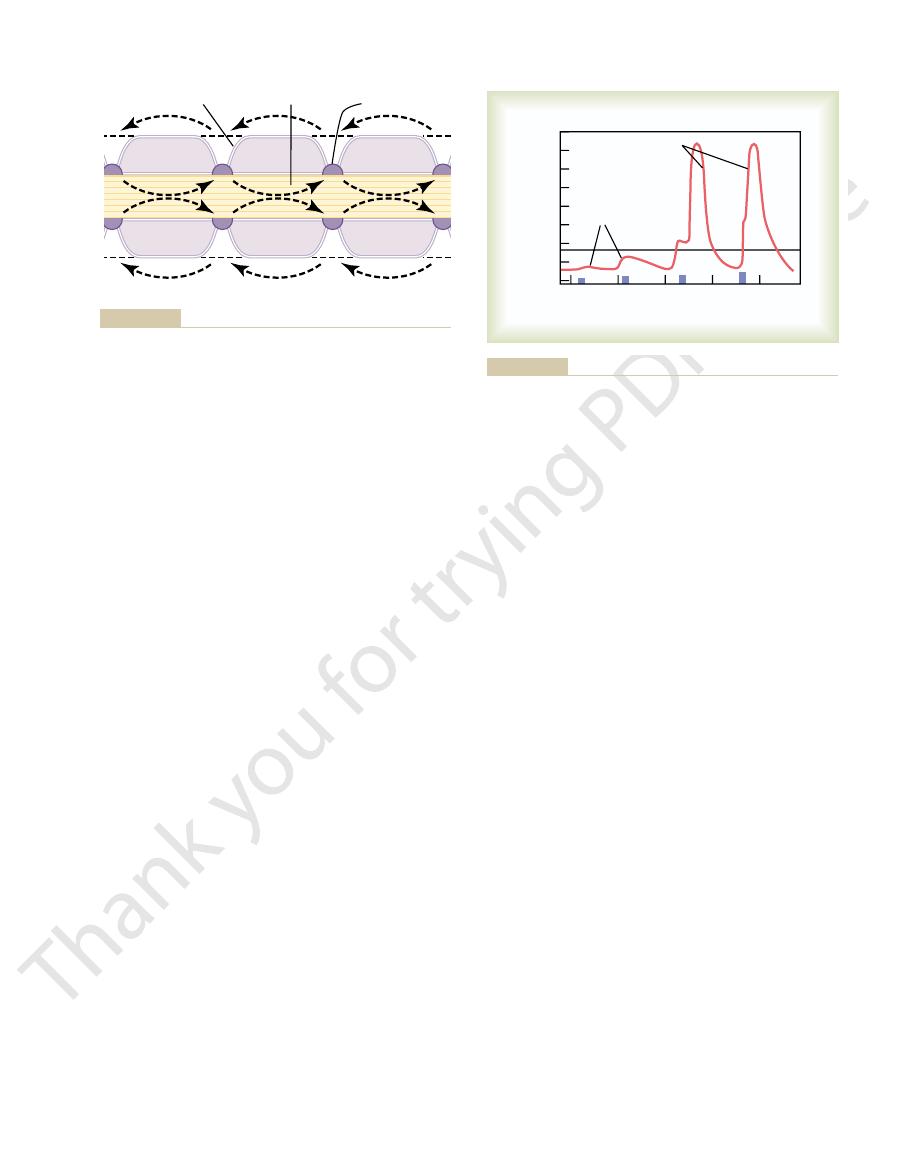
subthreshold potentials.
fail to elicit an action potential, they are called
acute local potentials,
after both of these weak stimuli. These local potential
The stimulus does, however, disturb the membrane
ulus is greater, but again, the intensity is still not enough.
of the action potential to develop. At point B, the stim-
85 millivolts, but this is not a suf
stimulus at point A causes the membrane potential to
applied stimuli of progressing strength. A very weak
take place. Figure 5
increased, there comes a point at which excitation does
ber. However, when the voltage of the stimulus is
it. This causes a state of hyperpolarization, which actu-
electrode, the injection of positive charges on the
ing in an action potential. Conversely, at the positive
brane and allows the sodium channels to open, result-
This decreases the electrical voltage across the mem-
ber.
cal voltage across the membrane. That is, negative
voltage-gated sodium channels. Further, these channels
The cause of this effect is the following: Remember
electrode.
the other positively charged. When this is done, the
electrodes, one of which is negatively charged and
The usual means for exciting a nerve or
Excitation of a Nerve Fiber by a Negatively Charged Metal
the excitation process, let us begin by discussing the
heart and intestine. For the purpose of understanding
neuron to the next in the brain, and electrical current to
to elicit nerve or muscle action potentials: mechanical
brane. All these are used at different points in the body
membrane, or passage of
chemical
disturbance of the membrane,
mechanical
the sodium channels. This can result from
Basically, any factor that causes sodium ions to begin to
Excitation—The Process
bers.
The velocity of con-
Velocity of Conduction in Nerve Fibers.
ization to occur with very little transfer of ions.
bers is the following: The excellent
impulses.
essary, and therefore requiring little metabolism for re-
because only the nodes depolarize, allowing perhaps
bers as much as 5- to 50-fold. Second,
ber, this mecha-
Saltatory conduction is of value for two reasons. First,
saltatory.
ber, which is the
Membrane Potentials and Action Potentials
Chapter 5
69
the nerve impulse jumps down the fi
origin of the term “
”
by causing the depolarization process to jump long
intervals along the axis of the nerve fi
nism increases the velocity of nerve transmission in
myelinated fi
saltatory conduction conserves energy for the axon
100 times less loss of ions than would otherwise be nec-
establishing the sodium and potassium concentration
differences across the membrane after a series of nerve
Still another feature of saltatory conduction in
large myelinated fi
insulation afforded by the myelin membrane and the 50-
fold decrease in membrane capacitance allow repolar-
duction in nerve fibers varies from as little as 0.25 m/sec
in very small unmyelinated fibers to as great as 100 m/
sec (the length of a football field in 1 second) in very
large myelinated fi
of Eliciting the Action
Potential
diffuse inward through the membrane in sufficient
numbers can set off automatic regenerative opening of
effects on the
electricity through the mem-
pressure to excite sensory nerve endings in the skin,
chemical neurotransmitters to transmit signals from one
transmit signals between successive muscle cells in the
principles of electrical stimulation.
Electrode.
muscle in the experimental laboratory is to apply elec-
tricity to the nerve or muscle surface through two small
excitable membrane becomes stimulated at the negative
that the action potential is initiated by the opening of
are opened by a decrease in the normal resting electri-
current from the electrode decreases the voltage on the
outside of the membrane to a negative value nearer to
the voltage of the negative potential inside the fi
outside of the nerve membrane heightens the voltage
difference across the membrane rather than lessening
ally decreases the excitability of the fiber rather than
causing an action potential.
Threshold for Excitation, and “Acute Local Potentials.”
A weak
negative electrical stimulus may not be able to excite a
fi
–18 shows the effects of successively
change from –90 to –
fi-
cient change for the automatic regenerative processes
potential locally for as long as 1 millisecond or more
changes are called
and when they
acute
1
2
3
Myelin sheath
Node of Ranvier
Axoplasm
current from node to node is illustrated by the arrows.
Saltatory conduction along a myelinated axon. Flow of electrical
Figure 5–17
1
2
Milliseconds
Millivolts
Threshold
Acute
subthreshold
potentials
Action potentials
3
C
B
A
D
4
0
+
60
+
40
+
20
-
20
-
40
-
60
0
stimuli are below the threshold value required for eliciting an
Note development of “acute subthreshold potentials” when the
Effect of stimuli of increasing voltages to elicit an action potential.
Figure 5–18
action potential.
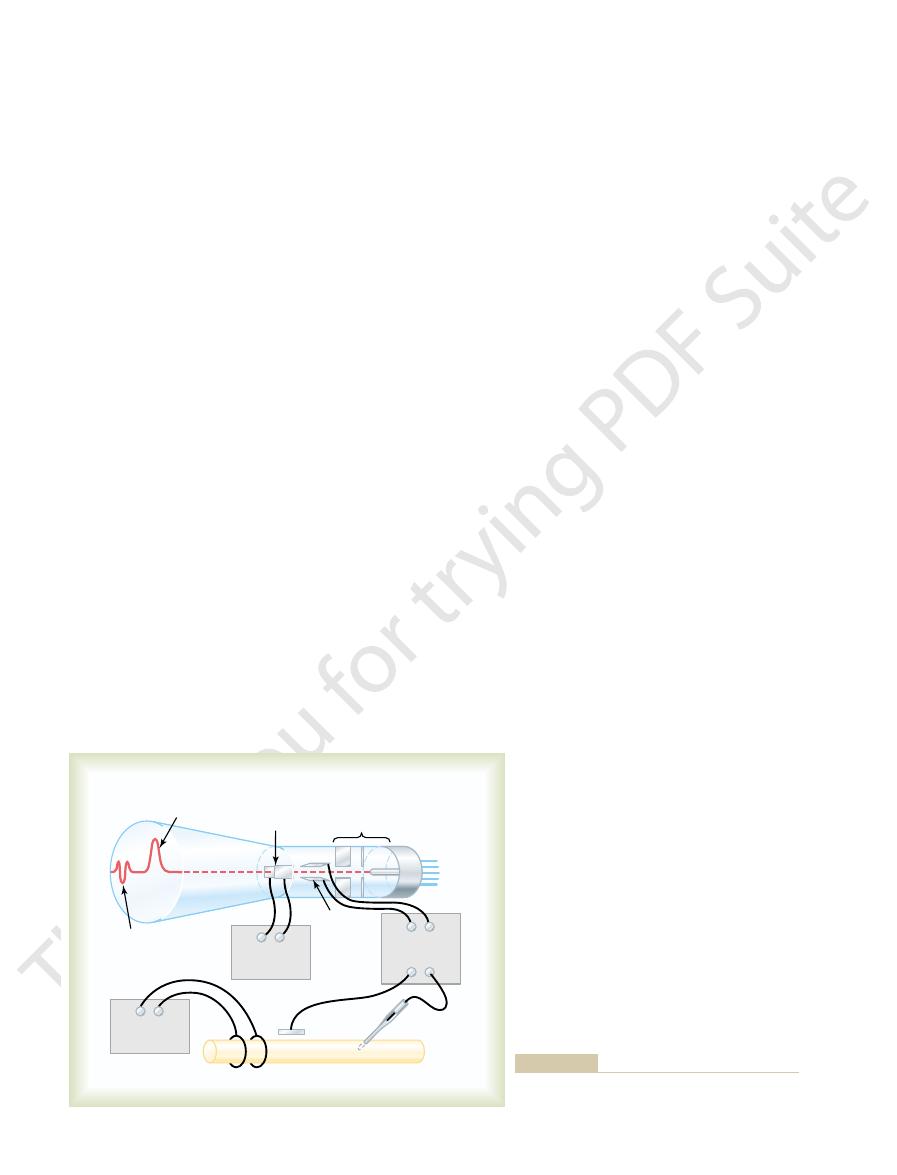
the electron beam is moved across the screen, the spot
uorescent material glows. If
hit the screen surface, the
red. Where the electrons
ray oscilloscope. The cathode ray tube itself is composed
Figure 5
the cathode ray oscilloscope.
extremely rapidly. For practical purposes, the only
recording these potential changes. However, it must be
of this chapter, an electrical meter has been shown
takes place in less than 1/1000 second. In some
during the course of an action potential. Indeed, most
Earlier in this chapter, we noted
Recording Membrane
fail to pass along the anesthetized nerves.
) is reduced below 1.0, nerve impulses
open, thereby reducing membrane excitability. When
nels, making it much more dif
tetracaine.
thetics, including
stabilizer.
excitability. Therefore, calcium ions are said to be a
For instance,
decrease excitability.
membrane-stabilizing factors, can
ity, still others, called
and Local Anesthetics
Inhibition of Excitability
Therefore, one can readily calculate that such a
This period for
cannot be elicited, even with a strong stimulus, is
The period during which a second action potential
nels open, and a new action potential can be initiated.
fraction of a second, the inactivation gates of the chan-
membrane potential level. Then, within another small
at this point will open the inactivation gates. The only
(or calcium channels, or both) become inactivated, and
after the action potential is initiated, the sodium channels
ceding action potential. The reason for this is that shortly
Stimulus Cannot Be Elicited
Potential, During Which a New
After an Action
old level before the action potential is set off.
lus causes a local potential change at the membrane, but
Thus, this
acute local potential is also stronger, and the action
At point D, the stimulus is still stronger, the
level required to elicit an action potential, called the
stronger. Now the local potential has barely reached the
18, the stimulus is even
At point C in Figure 5
Membrane Physiology, Nerve, and Muscle
70
Unit II
–
threshold level, but this occurs only after a short “latent
period.”
potential occurs after less of a latent period.
figure shows that even a very weak stimu-
the intensity of the local potential must rise to a thresh-
“Refractory Period”
A new action potential cannot occur in an excitable fiber
as long as the membrane is still depolarized from the pre-
no amount of excitatory signal applied to these channels
condition that will allow them to reopen is for the mem-
brane potential to return to or near the original resting
called the absolute refractory period.
large myelinated nerve fibers is about 1/2500 second.
fiber
can transmit a maximum of about 2500 impulses per
second.
—
“Stabilizers”
In contrast to the factors that increase nerve excitabil-
a high extracellular
fluid calcium ion concentration decreases membrane
permeability to sodium ions and simultaneously reduces
“
”
Local Anesthetics.
Among the most important stabilizers
are the many substances used clinically as local anes-
procaine and
Most of these
act directly on the activation gates of the sodium chan-
ficult for these gates to
excitability has been reduced so low that the ratio of
action potential strength to excitability threshold (called
the “safety factor”
Potentials and Action
Potentials
Cathode Ray Oscilloscope.
that the membrane potential changes extremely rapidly
of the action potential complex of large nerve fibers
figures
understood that any meter capable of recording most
action potentials must be capable of responding
common type of meter that is capable of responding
accurately to the rapid membrane potential changes is
–19 shows the basic components of a cathode
basically of an electron gun and a fluorescent screen
against which electrons are fi
fl
Vertical
Electrical
stimulator
Electronic
sweep circuit
Horizontal
plates
plates
Electron gun
Plugs
Nerve
Electronic
amplifier
Recorded
action potential
Electron
beam
Stimulus
artifact
Cathode ray oscilloscope for recording transient
Figure 5–19
action potentials.

short-term synaptic plasticity. Physiol Rev 84:69, 2004.
Xu-Friedman MA, Regehr WG: Structural contributions to
overview. Ann N Y Acad Sci 998:1, 2003.
Ruff RL: Neurophysiology of the neuromuscular junction:
Elsevier Science, 2002.
Pollard TD, Earnshaw WC: Cell Biology. Philadelphia:
axons at nodes of Ranvier. Nat Rev Neurosci 12:968, 2003.
Poliak S, Peles E: The local differentiation of myelinated
activated T-type calcium channels. Physiol Rev 83:117,
Perez-Reyes E: Molecular physiology of low-voltage-
Malden, MA: Blackwell Science, 1998.
Matthews GG: Cellular Physiology of Nerve and Muscle.
channels. Annu Rev Physiol 66:103, 2004.
Lu Z: Mechanism of recti
84:431, 2004.
propagation and associated arrhythmias. Physiol Rev
Kleber AG, Rudy Y: Basic mechanisms of cardiac impulse
excitation in nerve. J Physiol (Lond) 117:500, 1952.
Hodgkin AL, Huxley AF: Quantitative description of
eld, IL: Charles C Thomas, 1963.
Hodgkin AL: The Conduction of the Nervous Impulse.
neuronal networks. Nat Rev Neurosci 4:573, 2003.
Grillner S: The motor infrastructure: from ion channels to
the Cell. New York: Garland Science, 2002.
Alberts B, Johnson A, Lewis J, et al: Molecular Biology of
the recorded action potential itself.
nerve action potential. Then further to the right is
changes from the nerve electrodes shown vertically.
gure, giving a time base horizontally and voltage
electronic circuit of the oscilloscope. This gives the
nerves. The beam of electrons also is swept horizontally
tioned above and below. Appropriate electronic control
two sides of the electron beam, and the other set posi-
surface, the cathode ray tube is provided with two sets
Membrane Potentials and Action Potentials
Chapter 5
71
of glowing light also moves and draws a fluorescent line
on the screen.
In addition to the electron gun and fluorescent
of electrically charged plates—one set positioned on the
circuits change the voltage on these plates so that the
electron beam can be bent up or down in response to
electrical signals coming from recording electrodes on
across the screen at a constant time rate by an internal
record shown on the face of the cathode ray tube in
the fi
Note at the left end of the record a small stimulus arti-
fact caused by the electrical stimulus used to elicit the
References
Springfi
membrane current and its application to conduction and
fication in inward-rectifier K
+
2003.
